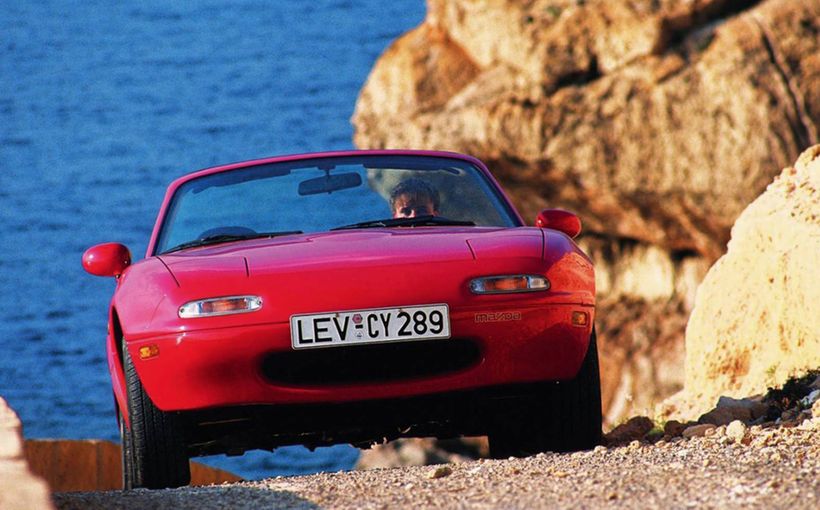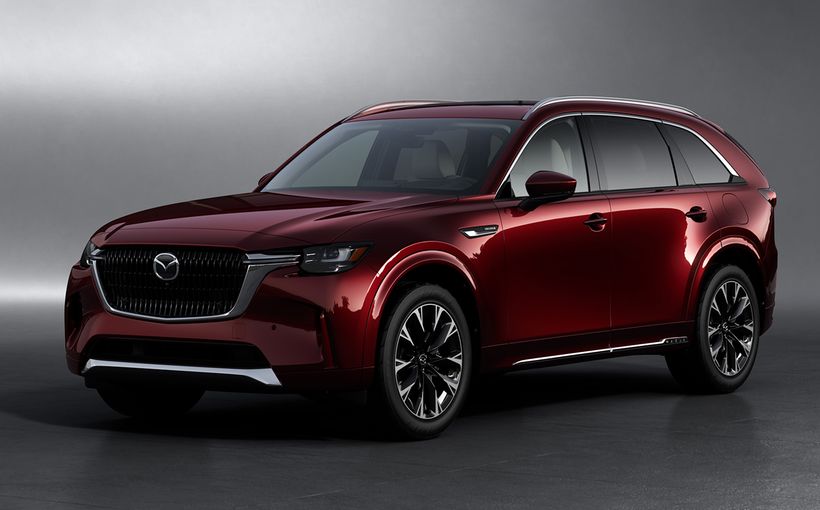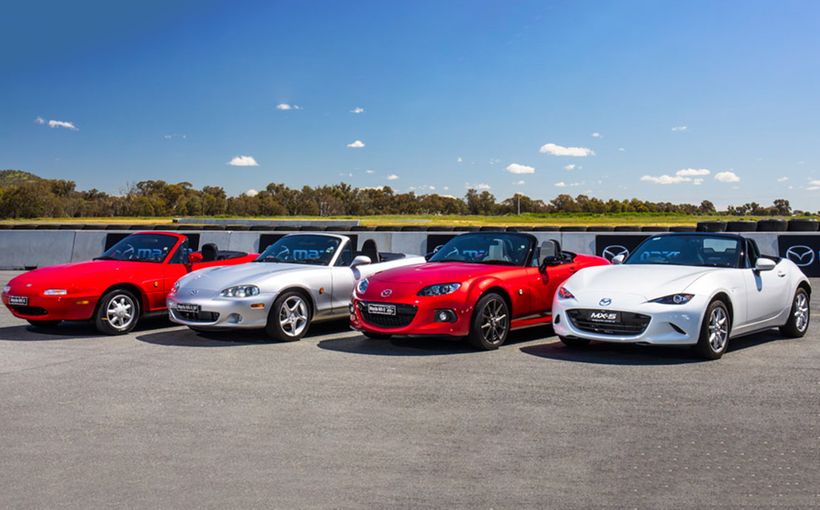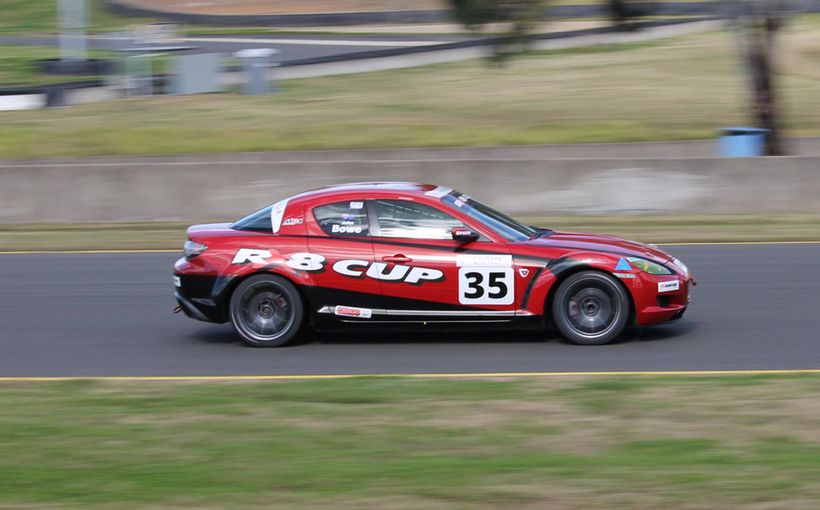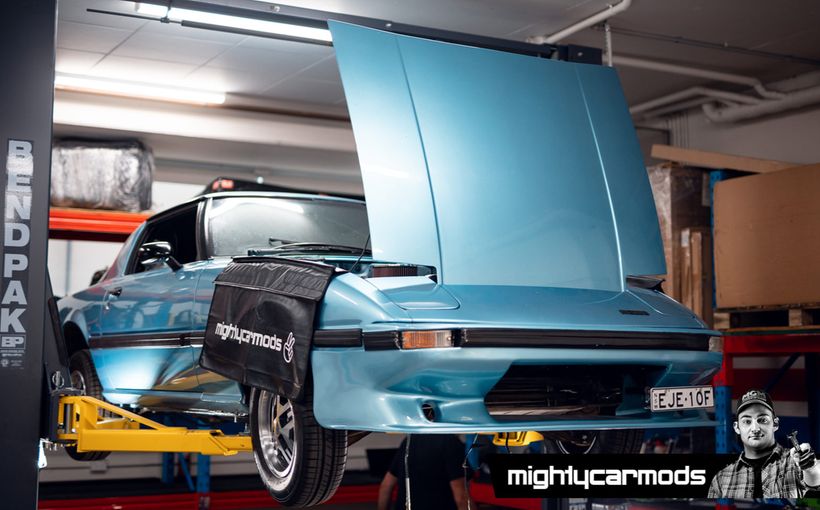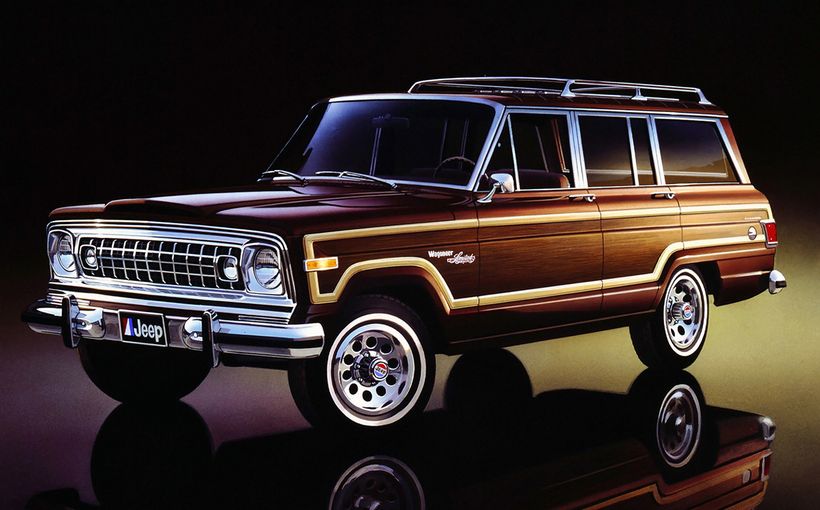Mazda RX-7 SP: The Aussie-designed supercar that conquered Porsche

Mazda’s twin-turbocharged FD RX-7 won three consecutive James Hardie 12 Hour production car races at Mount Panorama from 1992 to 1994. However, its victory in the first and only Eastern Creek 12 Hour in 1995 was arguably the most significant of its four 12 Hour wins, as it was achieved against a theoretically superior rival using a locally developed race special – the RX-7 SP.
The catalyst for the SP (Special Project) was arch rival Porsche which had tried and failed to beat the all-conquering RX-7s with its 968 Club Sport in both the 1993 and 1994 James Hardie 12 Hours at Mount Panorama. On paper the 968s appeared to have the necessary ingredients to grind the faster but thirstier Japanese rotaries into submission over 12 hours of racing, but on both occasions the works Mazda team proved too strong for the 3.0 litre German coupes.
Porsche was determined to put an end to such humiliation in 1995 when the race moved to Eastern Creek Raceway in Sydney. Any manufacturer that wanted to compete in the Australian GT Production Series (these cars were eligible for the 12 Hour) had to manufacture and homologate at least 10 identical road-registerable examples of the model they wished to race.

Porsche took full advantage of this rule by importing 10 examples of the super lightweight and extremely fast 911 RS Clubsport (CS) which the proud German manufacturer believed would finally put its cheeky Japanese rival in its place.
However, Mazda had no intention of losing its hard-won title as Australia’s production car endurance king and also put plans in place for a locally designed, limited-build homologation special of its own which could see off the latest Porsche challenger.
The end result was the mighty RX-7 SP of which less than 30 examples were built and which certainly delivered on the race track, with another emphatic victory over Porsche after 12 gruelling hours around Eastern Creek.
It was also the last time that these Japanese and Germans rivals would face-off in the annual production car race, as the 1995 event was fifth and final time the event would be run. So Mazda went out on a high, not only with four wins from four starts in Australia’s premier production car enduro but also in leaving an intriguing legacy thanks to the ultra-rare SP factory racer.

Planning for the SP
In January 1995 Mazda Motorsport manager Allan Horsley and Mazda Australia managing director Malcolm Gough first discussed the possibility of building a special RX-7 with the extra speed and durability required to tackle the Porsche 911 RSCS in the 12 Hour.
By February the concept was approved (codename ‘Mazda TT’) and a pivotal meeting between Horsley and a group of industry associates worked out what modifications would be required to defeat the new Porsche on the race track without compromising the RX-7’s road manners.
The SP concept mirrored that of Porsche’s RS philosophy, succinctly described by Phil Branagan in Chevron’s 1995 Australian Motor Racing Yearbook as: “basically to chuck out everything that doesn’t make the car go faster, bulletproof everything else and charge like a wounded bull for what’s left, with major league 270km/h performance.”
And that certainly applied to the 911 (aka 993) RSCS, based on the lightweight Carrera RS and powered by a potent naturally aspirated 3.8 litre flat-six with about 300bhp. The even more competition-focused Clubsport variant was supplied from the factory with a roll cage, larger chin spoiler and rear wing and deletion of creature comforts including audio system, air-con, power windows and even carpet to minimise weight.
Having analysed its new Porsche rival in great detail, the Mazda working group decided on an extensive list of 127 changes to the standard FD RX-7 to create the SP, which was a remarkable commitment given the tiny volume of cars with which to amortise those costs.

Engine
Modifications were aimed at increasing power and torque without compromising durability. Upgrades included a lighter flywheel, larger diameter exhaust pipe/dump pipe and larger turbo intercooler with water spray (sourced from the rear window washer bottle) and carbon fibre air-ducting for maximum cooling effect. There was also a special carbon fibre air box with ram-ducting, modified turbo seals for greater durability and a smaller, lighter battery. The standard ECU was retained as the modifications fell within its adjustment parameters.
Power increased from 176kW to 204kW (274bhp) and torque climbed from 294Nm to 357Nm with a 9000rpm rev limit. When Modern Motor conducted a detailed road test of an SP in 1995 it claimed a scant 6.07 seconds for 0-100km/h and a standing 400 metres in 13.98 seconds at just over 100km/h.
Body
The SP benefitted from a significant 92kg weight reduction with liberal use of carbon fibre and aluminium components. Compared to the standard FD RX-7 at 1310kg, the homologated weight for the SP was 1218kg even though the actual cars ended up being slightly heavier.
Each SP was equipped with a unique aluminium front-vented bonnet from Japan which was modified locally with extra vents for heat extraction and other tweaks that made it highly efficient. Also sourced from Japan were a Mazdaspeed prototype nose cone spoiler and rear wing which were modified locally to maximise aero performance. Lightweight Recaro carbon fibre seats contributed to this weight loss as well.

Fuel tank
A larger fuel capacity and longer time between drinks was considered a crucial advantage over Porsche in the 12 Hour, so a big 110-litre carbon fibre fuel tank was developed for the SP and used with great effect at Eastern Creek.
Differential
The standard RX-7 differential was replaced with a factory-supplied Torsen limited-slip centre with a punchier final drive ratio of 4.3:1.
Brakes
Also sourced through Mazda in Japan were larger brake discs and callipers. The race cars were also exclusively equipped with latest generation Endless competition brake pads which along with the larger fuel capacity played a decisive role in Mazda’s victory (see race report).

Wheels & Tyres
Larger diameter BBS wheels were specified for extra brake clearance and use of a lower profile tyre to improve handling. They also featured different rim widths front and rear. Fronts were 17 x 8.0-inch with 235/45 tyres while the rears were 17 x 8.5-inches with fatter 255/40 rubber. These SP wheels also featured unique centre caps with kangaroo winner’s garland motifs.
Badges & Body Markings
These were subtle and comprised an ‘SP’ rear decal, the special wheel caps, a Mazda Motorsport badge on the front suspension tower brace and triangular plates depicting a black kangaroo on black background in the front window corners.

1995 Eastern Creek 12 Hour
Like two prize fighters limbering up for their big bout, Mazda and Porsche both used the GT Production Series to fine-tune their new weaponry and driver squads for the Eastern Creek clash in late August. The 12 Hour field was divided into six classes, with the German and Japanese juggernauts entered in Class X for Extra High Performance cars.
The 911 RSCS Porsches of Jim Richards and Peter Fitzgerald and Mazda’s new RX-7 SP arrived half-way through the GTP season and although the German cars showed superior speed in the sprint races to romp away with the title, there were few prepared to write off Mazda in the biggest production car race of the year.
Three of the new Porsches were entered for the 12 Hour with Richards and Fitzgerald teamed in one car, backed up by Geoff Morgan/John Smith and Andrew Miedecke/Mark Noske in the other two.
Mazda’s two-car factory attack comprised one RX-7 SP for the dynamic duo of Dick Johnson and John Bowe, backed by another example for Garry Waldon and Mark Skaife with Allan Grice on hand as a back-up driver if required. Terry Bosnjak entered a third ‘semi-works’ RX-7 SP with F1 champ Alan Jones but it differed from the works cars in some areas and would retire from the race early with electrical problems.

Porsche showed ominous pace in qualifying by claiming the first three grid positions, with pole-sitter Fitzgerald stopping the clocks several seconds under the class record. The fastest Mazda was the Waldon/Skaife SP but a driving error by Allan Grice late in the qualifying session resulted in the black machine making heavy contact with a concrete wall. Grice was okay but the RX-7 incurred serious damage, requiring a frantic overnight rebuild to make the pre-dawn start. The hastily rebuilt car wasn’t quite right though and would struggle.
When the race started at 6am the flying Porsches were true to their qualifying form running first, second and third in the early laps, but John Bowe in the white works SP (which had taken a back seat in qualifying to concentrate on race set-up) came storming through the field and after 20 mins was leading the race.
“The first round of pit stops gave a good indication of the pattern of the race,” Branagan wrote. “Unlike previous years, the Mazdas had a range advantage of between five and 15 minutes thanks to their (110 litre) tanks and the Porsches were proving hard on - and blistering – their admittedly soft Falken tyres.”
With mid-morning temperatures climbing into the 30s, track temperatures soared into the 40s which was causing concern for numerous teams, particularly those with turbocharged engines and brakes and tyres that weren’t up to the job.

However, Mazda had done its homework with the SP and the twin-turbo rotary was thriving in the hot conditions. The team’s decision to opt for a larger fuel tank was also proving critical in the battle for the race lead. The Fitzgerald/Richards Porsche was setting faster times only for the Johnson/Bowe Mazda to regain the upper hand with longer stints between fuel stops. It was an intense fight.
The Mazda team then took full advantage of a messy deployment of the Safety Car at a crucial time in the race, which Porsche teams claimed handed the Johnson/Bowe Mazda an unfair advantage (a protest was lodged but later dismissed). Even so, the Fitzgerald/Richards Porsche chased the leading Johnson/Bowe Mazda all the way to the 6pm chequered flag with Bowe suffering severe cramps in the closing stages. The hastily rebuilt team car of Waldon/Skaife finished a fighting fourth behind two of the Porsches in second and third.
Mazda had once again proved its superiority over Porsche in production car endurance racing, this time with a locally designed and built homologation special which had been tailor-made to outperform one of the world’s greatest high performance thoroughbreds.

The key strategic advantages which emerged during the race were the SP’s larger fuel capacity and the phenomenal performance of its new Endless brake pads, which allowed the winning RX-7 SP to complete 12 hours of racing with only a visual check of the brakes.
“Horsley’s team had obviously identified braking as one of the key areas to be improved and he was right,” concluded the AMRY race report. “Other Mazdas (notably the Bosnjak/Jones car which changed both front and rear pads and warped discs early in the race) fell foul of the bugbear - but not Horsley’s. Both of his cars went through all 12 hours without so much as a pad change, an astonishing achievement for a ‘showroom’ sports car.
"Sources close to the team revealed that they had the exclusive use of specially developed (Endless) pads which wore down to half-used at the normal rate then virtually stopped wearing. Experts from SPV (Special Projects Dept) inspected the wear as required but did not order a change during all 12 hours.”

It was a brilliant result for Mazda given that the locally developed RX-7 SP sold for $101,610, which was less than half the price of its Porsche rival ($218,000). Even so, it was still the most expensive Mazda in the world. And the fastest, winning high praise from car magazine testers which rated it amongst the finest high performance road cars on a global scale.
According to Mazda documents, a total of 29 RX-7 SPs were built by Mazda Motorsport in Sydney. 26 of those were sold new as road cars with minor differences (choice of seats, fuel tanks etc) but no records were kept of those variations. The remaining three SPs were built as media test cars, two of which became the race cars. The third media car was later stolen and burnt.
The 1995 12 Hour victory for the definitive SP version of the twin-turbo RX-7 was the icing on a sizeable cake for Mazda Australia. In fact, its four consecutive 12 Hour wins were so highly regarded by the company’s head office in Japan that in 2001 it named its Japanese domestic model RX-7 ‘The Bathurst’ in recognition of the Aussies' achievements with what was clearly a remarkable car.



